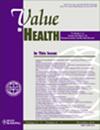心血管疾病一级预防因果模型:心血管疾病一级预防卫生经济模型(HEM-PPCVD)。
IF 4.9
2区 医学
Q1 ECONOMICS
引用次数: 0
摘要
目标:我们的目标是设计并开发一个开源模型,该模型能够模拟心血管疾病(CVD)一级预防的干预措施,其中包含风险因素(如胆固醇年或血压年)的累积效应,从而在无法进行临床试验的情况下加强卫生经济建模:我们查阅了相关文献,选择了心血管疾病最重要的致病风险因素--低密度脂蛋白胆固醇(LDL-C)、收缩压(SBP)、吸烟、糖尿病和脂蛋白(a)(Lp(a)),以及最常见的心血管疾病--心肌梗死和中风,从而设计了模型结构。该模型的流行病学基础包括模拟风险因素轨迹,通过孟德尔随机化得出的因果效应估计值来改变心血管疾病风险。低密度脂蛋白胆固醇(LDL-C)、血压(SBP)、脂蛋白(a)和吸烟都会对心血管疾病风险产生累积影响,这些影响都被纳入了健康经济模型。模型的数据主要来自英国生物库研究。我们使用临床试验数据对模型进行了校准,并根据观察到的英国生物库数据对模型进行了验证。最后,我们进行了一次健康经济分析,以展示该模型的实用性。该模型开源:该模型在所有验证测试中均表现良好。结果:该模型在所有验证测试中均表现良好,能够从一个健康经济分析示例中得出可解释且合理的结果(符合现有文献的预期):我们构建了一个开源健康经济模型,该模型能够纳入低密度脂蛋白胆固醇(LDL-C)(即胆固醇-年)、血压(SBP-年)、脂蛋白(a)和吸烟对终生心血管疾病风险的累积效应。本文章由计算机程序翻译,如有差异,请以英文原文为准。
A Causal Model for Primary Prevention of Cardiovascular Disease: The Health Economic Model for the Primary Prevention of Cardiovascular Disease
Objectives
Our objective was to design and develop an open-source model capable of simulating interventions for primary prevention of cardiovascular disease (CVD) that incorporated the cumulative effects of risk factors (eg, cholesterol years or blood-pressure years) to enhance health economic modeling in settings which clinical trials are not possible.
Methods
We reviewed the literature to design the model structure by selecting the most important causal risk factors for CVD—low-density lipoprotein-cholesterol (LDL-C), systolic blood pressure (SBP), smoking, diabetes, and lipoprotein (a) (Lp(a))—and most common CVDs—myocardial infarction and stroke. The epidemiological basis of the model involves the simulation of risk factor trajectories, which are used to modify CVD risk via causal effect estimates derived from Mendelian randomization. LDL-C, SBP, Lp(a), and smoking all have cumulative impacts on CVD risk, which were incorporated into the health economic model. The data for the model were primarily sourced from the UK Biobank study. We calibrated the model using clinical trial data and validated the model against the observed UK Biobank data. Finally, we performed an example health economic analysis to demonstrate the utility of the model. The model is open source.
Results
The model performed well in all validation tests. It was able to produce interpretable and plausible (consistent with expectations of the existing literature) results from an example health economic analysis.
Conclusions
We have constructed an open-source health economic model capable of incorporating the cumulative effect of LDL-C (ie, cholesterol years), SBP (SBP-years), Lp(a), and smoking on lifetime CVD risk.
求助全文
通过发布文献求助,成功后即可免费获取论文全文。
去求助
来源期刊

Value in Health
医学-卫生保健
CiteScore
6.90
自引率
6.70%
发文量
3064
审稿时长
3-8 weeks
期刊介绍:
Value in Health contains original research articles for pharmacoeconomics, health economics, and outcomes research (clinical, economic, and patient-reported outcomes/preference-based research), as well as conceptual and health policy articles that provide valuable information for health care decision-makers as well as the research community. As the official journal of ISPOR, Value in Health provides a forum for researchers, as well as health care decision-makers to translate outcomes research into health care decisions.
 求助内容:
求助内容: 应助结果提醒方式:
应助结果提醒方式:


